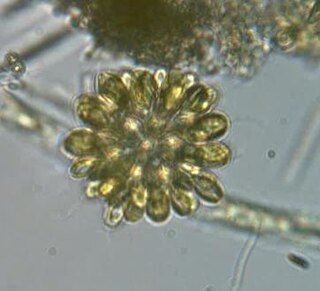
The synurids are a small group of heterokont algae, found mostly in freshwater environments, characterized by cells covered in silica scales.

The chlorarachniophytes are a small group of exclusively marine algae widely distributed in tropical and temperate waters. They are typically mixotrophic, ingesting bacteria and smaller protists as well as conducting photosynthesis. Normally they have the form of small amoebae, with branching cytoplasmic extensions that capture prey and connect the cells together, forming a net. They may also form flagellate zoospores, which characteristically have a single subapical flagellum that spirals backwards around the cell body, and walled coccoid cells.

Brown algae are a large group of multicellular algae comprising the class Phaeophyceae. They include many seaweeds located in colder waters of the Northern Hemisphere. Brown algae are the major seaweeds of the temperate and polar regions. Many brown algae, such as members of the order Fucales, commonly grow along rocky seashores. Most brown algae live in marine environments, where they play an important role both as food and as a potential habitat. For instance, Macrocystis, a kelp of the order Laminariales, may reach 60 m (200 ft) in length and forms prominent underwater kelp forests that contain a high level of biodiversity. Another example is Sargassum, which creates unique floating mats of seaweed in the tropical waters of the Sargasso Sea that serve as the habitats for many species. Some members of the class, such as kelps, are used by humans as food.

The Chamaemyiidae are a small family of acalyptrate flies with less than 200 species described worldwide. The larvae of these small flies are active and predatory and are often used for biological control of aphids, scale insects, and similar pests. Chamaemyiid fossils are poorly represented in amber deposits, but a few examples are known from the Eocene epoch onwards.
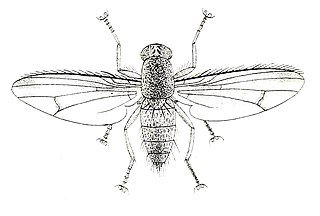
The Curtotonidae or quasimodo flies are a small family of small grey to dark brown humpbacked flies (Diptera) with a worldwide distribution, but with very few species in the Nearctic, Australasian/Oceanian, and Palaearctic regions. Most members of the family are found in tropical to subtropical latitudes in Africa and the Neotropics. Many remain undescribed in collections, since little work on the family has been done since the 1930s.

The Coelopidae or kelp flies are a family of Acalyptratae flies, they are sometimes also called seaweed flies, although both terms are used for a number of seashore Diptera. Fewer than 40 species occur worldwide. The family is found in temperate areas, with species occurring in the southern Afrotropical, Holarctic, and Australasian regions.
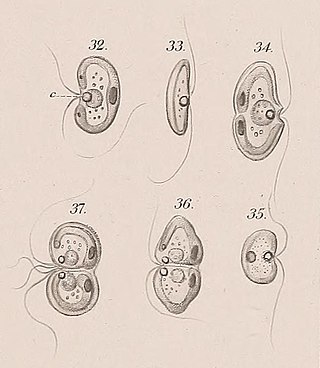
Nephroselmis is a genus of green algae. It has been placed in the family Nephroselmidaceae, although a 2009 study suggests that it should be separated into its own class, Nephroselmidophyceae. One species can be an endosymbiont of Hatena arenicola.

Selenastrum is a genus of green algae in the family Selenastraceae. It is common in freshwater habitats around the world. Most species prefer temperate or warm-temperate waters.

Althenia is a genus of aquatic plants of the family Potamogetonaceae. This has long been a group of two species in the Mediterranean Europe and South Africa, but in 2016 was revised to include an Australasian relative, Lepilaena. The genus is named after the agronomist Jean Althen.

Chaetotaxy is the arrangement of bristles (macrochaetae) on an arthropod or annelid, or taxonomy based on their position and size. For example, it is important in Diptera, in which group it was formalised by Ernst August Girschner. The term chaetotaxy was later proposed by Carl Robert Osten-Sacken.
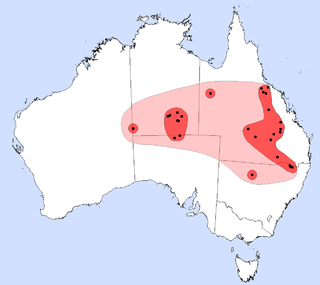
Setirostris eleryi is a species of small insectivorous bat found in inland eastern Australia. It is the sole species of the molossid genus Setirostris, a name that refers to the coarse bristles on their faces. Earlier common names have referred to this unique feature, and the 'free-tail' that is a common feature of its microchiropteran family, the Molossidae; no single common name emerged during the taxonomic revisions that identified what was referred to as the bristle-faced freetail.
Karenia papilionacea is a species from the genus Karenia, which are dinoflagellates. It was first discovered in New Zealand.
Karenia bicuneiformis, also known as Karenia bidigitata is a microbial species from the genus Karenia, which are dinoflagellates. It was first discovered in New Zealand.
Mallomonas lacuna is a species of heterokont algae. It is a tiny free-living cell, about the width of a human hair. It has ornate scales and bristles, as well as long spines. It is a relatively common part of lake or pond plankton. It differs from its cogenerates by the number, distribution, and size of its base plate pores, the secondary structures on the scale surfaces, together with characteristics of its bristles.
Mallomonas pseudomatvienkoae is a species of heterokont algae. It is a tiny free-living cell, about the width of a human hair. It has ornate scales and bristles, as well as long spines. It is a relatively common part of lake or pond plankton. It differs from its cogenerates by the number, distribution, and size of its base plate pores, the secondary structures on the scale surfaces, together with characteristics of its bristles.
Mallomonas sorohexareticulata is a species of heterokont algae. It is a tiny free-living cell, about the width of a human hair. It has ornate scales and bristles, as well as long spines. It is a relatively common part of lake or pond plankton. It differs from its cogenerates by the number, distribution, and size of its base plate pores, the secondary structures on the scale surfaces, together with characteristics of its bristles.
Mallomonas pleuriforamen is an extinct species of heterokont algae. It was first found in Middle Eocene lacustrine deposits from northwestern Canada. It was a tiny free-living cell, about the width of a human hair. It had ornate scales and bristles, as well as long spines. It was a relatively common part of lake or pond plankton. It differs from its cogenerates by the number, distribution, and size of its base plate pores, the secondary structures on the scale surfaces, together with characteristics of its bristles.
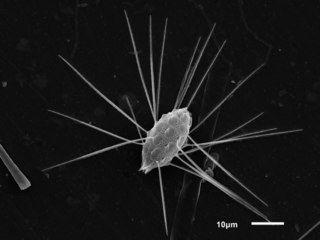
Mallomonas is a genus comprising unicellular algal eukaryotes and characterized by their intricate cell coverings made of silica scales and bristles. The group was first named and classified by Dr. Maximilian Perty in 1852. These organisms live in freshwater and are widely distributed around the world. Some well known species include Mallomonas caudata and Mallomonas splendens.

Synura is a genus of colonial chrysomonad algae covered in silica scales. It is the most conspicuous genus of the order Synurales.











